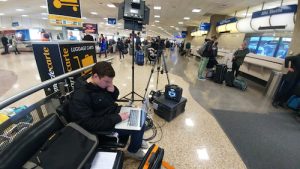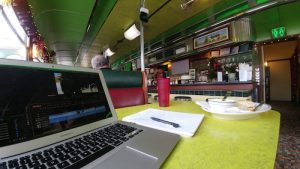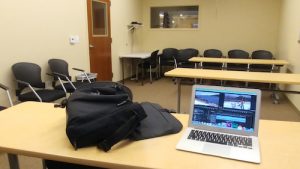7 PKGs
What is a Package?
The package, abbreviated PKG or PAK, is the reporter’s basic report. It is pre-written and the voice track is pre-recorded, so it can be edited to have video very precisely match the audio track. Soundbites and natural sound breaks (called NATS) can be edited tightly since they are pre-produced on an editing system.
Typically, the anchor introduces the PKG on set, then the director calls for it to play, and the anchors’ mics are cut as the viewers see the story full-screen. A variation of this is the anchor tossing to the reporter either on set, on a side set, or in the field live. The reporter takes the toss from the anchor/s and introduces her own PAK (we are using PAK and PKG interchangeably). After the package runs, the reporter may tag it and then toss back to the anchor/s. If the reporter introduces her own PKG in the field, it may be called a donut.
The script for the anchor or reporter to introduce the PKG is called the on-cam intro. The last words the anchor or reporter says that let the director know when to switch to the PKG are called the roll cue. Ad-libbing a little in the intro is OK, but should end with a roll cue the director can recognize. If you throw off a director while introducing your package, you’re going to end up staring at the camera and waiting for him to figure out you’re done talking and get the package playing on air.
Packages can run 50 seconds (typically called a mini-pak) on the light side. The average in the 1980s and 1990s was two minutes, but that has been shrinking, and averages about 1:30 now. In-depth stories can run longer than three minutes, but not without planning ahead with the producer.
Reporters are typically assigned stories in the morning meetings. Some stations’ assignment desk might help set up interviews and b-roll, but at others, it is solely the responsibility of the reporter.
How To Produce Packages
The minimum number of interviews for a package is two, but more people/sources are better. Find the experts from both sides of an issue and the affected and/or witnesses, depending on the topic. Log and choose soundbites using the criteria from Chapter 7.
Often you can shoot b-roll after the interviews, which helps ensure you have video of what the interviewees talked about. For spot news this is often not the case: If a building is burning, shoot the flames first, get reactions and official information after; usually the fire chief is busy until things literally cool down anyway.
As you shoot (MMJ) or assist (reporters with photographers), look for natural sounds that will help bring your viewer into the story. These can be the sound of traffic going by, a siren, a bird chirping, swimmers splashing, a nurse checking on a patient—whatever. If you hear a good sound that could introduce a new area of your story, shoot more video to complete a sequence. Repeat this for every new thought or area you want to cover. For example, imagine you have been sent to do a story about winter’s first snowstorm and its effects on a well-traveled canyon. You get solid sound of the cars driving in snow, and then a few more shots of cars, a mix of telephoto and near shots.
Then you get to the bad area. You get shots of spinning tires, people pushing cars, and cars getting stuck. Make sure some of these are close enough for good sound. Interview a few stuck or struggling drivers. Later you find someone from the Highway Patrol. In Utah, all troopers are authorized to talk on camera. When dealing with other agencies, you may need a sergeant or lieutenant. The trooper can give you the who, what, when, where, why, and how about what is happening. She might also give some reaction, whether it be advice, frustration, or surprise.
After the interview you set out to shoot things the trooper talked about that you want to put in your story. You don’t need b-roll of everything she said, but when in doubt of whether you’ll use the footage, shoot it. Better to have and not need than need and not have.
Looking for what is out of the ordinary, you stop for some tow trucks pulling cars out of snowbanks. If it’s safe, you can get close enough for NATS. Try to shoot these from the shoulder side, not the highway side. If the tow drivers look too busy to clip your mic on, just shout a question at ‘em as they work. If they shout back loud enough, you can use a quick response. In my experience covering this kind of story, a tow driver said he loved the first storm of the year because they were “money makers.” I wasn’t sure it was loud enough for the mic to pick up, so I yelled “what?” and he repeated the same words louder and clearer.
Once again, after you get a quick NATS or SOT, get more video to follow up for your future script.
With interviews from an official, reactions from drivers and tow drivers, and plenty of video and sound of each, you can go log. If your station is nearby, log there. If not, you might be spending the day in your car.
Logging in an airport, library, and diner.



Rather than idling your engine for hours, try logging in a nearby library or empty restaurant (don’t take up tables if they need them for new customers).
How do you start your script? Use these guidelines to help you put something on that blank page:
Start the package and each new aspect or thought with natural sound or a compelling soundbite.
In this case, we can start with a quick NATS pop of cars driving by in snow, followed by the script THE SNOW DIDN’T LOOK THAT BAD AT THE BOTTOM OF SARDINE CANYON.
Your package has started. Now on to the next thought in it, where the road conditions get bad. Use the NATS of a spinning tire, then BUT GRIPPING TURNED TO SLIPPING THREE MILES UP. You used the natural sound full to transition, and the next words addressed the NATS. You might have to adjust the order of your sentence, slipping into passive voice if absolutely necessary to put the words about the NATS right up next to the NATS. Awkward sentence structure is not good, but our rule number one is Write to Video. Now that you have shown action, put in some reaction with a stuck driver and/or Highway Trooper SOT(s). You could then put in more track as you summarize the conditions and response.
Use NATS again to transition to the tow truck driver, write a line that ties the NATS up to the SOT: THOUGH THEIR CHAINS AND HYDRAULICS ARE GETTING A WORKOUT, THE TOW DRIVERS DON’T MIND [TAKE SOT] “The first storms of the season are great. They’re moneymakers.” Close the package with perhaps another SOT from a driver or trooper, then give your sign-out: “Joe Reporter, A-TV News.”
This book is about writing, not video editing. When you edit, however, lay down all of the NATS, SOTS, and track first. These affect the length of the piece. This is called “A-Roll,” a term from film. Once they’re down, you can tell your producer about how long the story will be. If the producer gasps, you can remove or rewrite before you’ve invested all the time to cover the track with video, which is called “B-Roll.”
Once you get the script delivered to your editor, write the anchor intro and tag and supers for your producer. If you are an MMJ, write them whenever it fits best in your environment.
Those are the basics of how a package is done–now let’s look at how to do them well.
Recording Your Voice Track
You should record your voice in a professional audio booth if your station has one. A good booth will have sound-deadening foam, a microphone on a stand, and hopefully something to hold your script like a clip or a music stand. Your hands should be free so you can make gestures.
If you don’t have access to a professional booth, try to create one as best as you can in your environment. If you are in a car, shut off the engine, or the air conditioning at the very least. If you’re in a home, find an area with soft surfaces like the side of a bed on a carpeted floor. Kitchens and bathrooms give too much echo. If you’re stuck somewhere with hard surfaces, consider using a jacket, blanket, or towel to surround you and the microphone; put them over your head like an old-time photographer if need be. In my experience, fleece fabric absorbs sound the best, but will mess up your hair.
I assume you’ll be recording your voice with a camera. If a photographer is recording for you, have her hold up a finger in front of the lens with the track number; this will make it easier to find the right track later.
You may consider using an audio recorder, like a Samsung Zoom. I use a basic Zoom H1 for my voice and end up with an mp3 file when I’m done. The Zoom plugs into my computer so I can drag the file right over when I’m done, and mp3 or even wave files are much smaller than the video file would be if you used your camera to track.
As you track, try to tell the story, not just read words. Talk as you would to your friends, and use gestures—yes, you can hear the difference if someone is physically animated as they speak. It’s OK if you goof up, you can just start up again and patch it together in editing. Edited track must be perfect.
Standups
The standup is the part of the package where the viewers get to see who’s talking to them, which is important. They run between 5-20 seconds depending on what you’re saying and doing. If you stand in front of a building or sign, while holding a stick mic and just talking, you are doing what is called a “thumbsucker.” You have shown viewers your face, and have just shown everyone else you are not very creative. Better to treat standups as show-and-tell. Demonstrate something or point out how or where something was done. Your station gave you a wireless mic for a reason. If you don’t have a wireless, you can still walk, talk, show, and tell. This is a chance to show viewers (and potential employers watching your resume reel) that you understand and command your medium.
Standups should be flawless, since you can do as many takes as necessary to get them right. I usually need 3-5 takes to get everything right. As a photographer in a top-market, I shot 20 takes for a reporter who just couldn’t get it right. In market 111 (at the time) I worked with a reporter who did his standup in one take. The problem was, I was doing a pan/zoom out and assumed he would need multiple takes like everyone else and I’d have a few chances to practice my camera moves. I had to ask him to do it again.
If you’re doing 10 or fewer takes you’ll be fine. I ask reporters (and especially students and interns) to say their standup three times perfectly before I even turn the camera on.
So where in the story does a standup go? Rarely at the beginning—these days that may be done, but it is called an as-live or look-live and mimics the look of a real live shot. You can end a package with a standup, but these often end up as thumbsuckers.
In the montage above, notice that I am interacting with my surroundings, and mention that early on.
Besides a demonstration, standups can be used as a bridge from one thought to another. Going back to the Snow Drivers story, perhaps you want to visit a local tire store to see if snow tire sales picked up on the first day of real snow. Up in the canyon, you crouch down by a stuck car and say THIS CAR’S TIRES ARE STUCK . BUT MAYBE THE TRACTION PROBLEM ISN’T ALL SNOW. SOME OF IT COULD BE THE TIRES THEMSELVES. This sets you up to have your next shot be at the tire store. You could use a NATS pop of the air-impact wrench taking off lug nuts, or a sound bite of the tire store manager saying, “First storm of every year people find out their tires aren’t going to make it.”
Notice how the sentence was arranged to have you mention the tires at the beginning so it’s clear why you’re cuddling up to a tire and ends ready for the soundbite or NATS pop.
Standups can bridge two soundbites in a less-visual story: Follow the guidelines for writing up to a soundbite. Because packages keep going, remember to write to and from SOTs and NATS.
The Diamond Approach
When given a story about a larger problem (or good thing), you can try the diamond approach to the story by finding someone/something representative or affected by it. A local county was cutting its supplemented housing checks. We found a mother who depended on the assistance. We started the story with NATS of her doing some dishes, learned her story, and then introduced the county-wide cuts. We used soundbites from the country administrator explaining why this was happening, and then wrapped the story up by going back to the mother.
Here is an example of the Diamond Approach I shot and edited, but did not write for KUTV:
It starts and ends with the store that pulled the fireworks, and goes into the WHY and broader issue in the middle.
What is a budget cut? What does it look like? Budgets don’t watch TV; introduce us to people affected by both sides of an issue.
People
If you are describing your story to your producer, you had better include people. A new stop sign on a once-peaceful road is not about signs, safety, or traffic; it is about how people will/won’t like it, people will be safer/in more danger, and people who tried to stop it/get it done.
I arrived at KEYT a month or two after the big Santa Barbara fire. The photographers had gotten lots of great video of enormous flames. Later, there were signs up at the station that read, “Flames don’t watch TV.” Yes, get a shot of (and write about) big, house-devouring flames, but your next shot should be about the people affected.
Crashed cars don’t watch TV: Shoot the people and record their reactions and changed lives.
Torrential rains, extreme heat/cold, blizzards, hurricanes, and tornadoes don’t watch TV: Shoot how these will affect your viewers.
Heart-warming puppies and kittens don’t watch TV: Can your viewers adopt them? Do the puppies help people with PTSD?
New construction projects don’t watch TV: Whose lives will be affected?
Basically, every story is about people. A comet that only passes earth every 100 years is interesting, but still should be tied into people.
Thinking Visually
Television is the medium of motion and sound. Many stories get advanced because they are motion- and sound-rich; others get rejected because they are considered too abstract. There are, however, ways to overcome what might be a visually-poor story. When deciding if a story is visual or not, ask, “What can I point the camera at?” and beware of wallpaper answers.
Most stories, through the Diamond Approach, can be made visual. What do layoffs look like? Higher internet speeds? Kindness? Discrimination? Love? Economic Sanctions? Poverty? Most stories with an abstract (nothing to point the camera at) topic can be made visual by finding an example of the effects on people.
You might also consider metaphor, if appropriate. You can use a popular, established metaphor: “They say time is money. With the new highway project’s delays, what uses to cost you 35 cents in time (coins clink) will now cost you three dollars and sixty-five cents (more clink, or you slide the stacks next to each other for comparison).
Some government reporters are quite good at creating their own metaphors. If uninsured people are dragging down the progress of a government program, hitch a trailer to a car, get a rowboat and someone to hang on the outside of it, or just tie a heavy weight around someone—you could try this at a gym. Just make sure to explain it and not let it get too distracting.
One of your biggest challenges in the future is that more and more newsworthy stories happen on computers and mobile devices, and not in the “real world.” You’ll need creative ways to cover apps, internet fraud, and computer programs.

